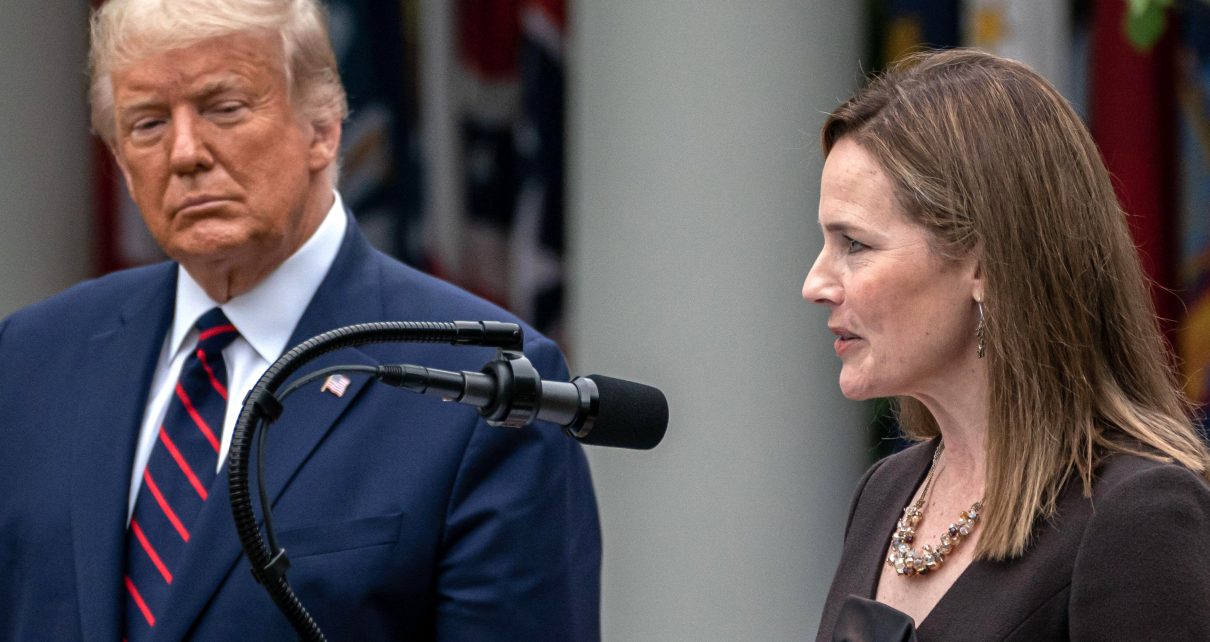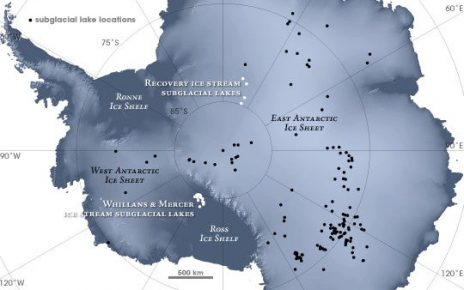With Judge Amy Coney Barrett poised to become the sixth Republican-nominated justice on the nation’s highest bench, environmental law experts see her influence tipping the scales on energy and climate rules.
President Trump tapped Barrett on Saturday, and Trump—with the help of a Republican-led Senate—is intent on swiftly filling the position left by the late Justice Ruth Bader Ginsburg, who was nominated in 1993 by President Clinton, a Democrat (Greenwire, Sept. 26).
Barrett, who currently serves on the 7th U.S. Circuit Court of Appeals, has a relatively slim record on climate and environmental matters. But if she is confirmed to the high court, Barrett, 48, likely would lock up a conservative coalition there, legal experts said. That bloc could smooth the path for future environmental rollbacks or make it more difficult to expand emissions regulations through a broad reading of statutory authority.
“I view Barrett being added to the court as taking it even further in the direction it was already going,” said Jody Freeman, founding director of the Environmental & Energy Law Program at Harvard Law School.
The court “was already headed in the direction of [being] much more skeptical of broad efforts to regulate new problems, to interpret statutes that may be older, to deal with new risks,” she added.
That momentum could be a boon for Trump’s legacy of relaxing environmental standards, as a conservative high court likely would be more amenable to his viewpoint in legal challenges to those efforts. Trump has pushed to roll back regulations on vehicle, power plant and industry emissions.
“If you look at what Trump has done on NEPA regulations, ACE, WOTUS, they are doing rulemakings that don’t push the envelope, [they are] narrow interpretations of law that I think the court would actually be sympathetic to,” said Brett Hartl, government affairs director at the Center for Biological Diversity, referring to the National Environmental Policy Act, EPA’s Affordable Clean Energy rule and the “Waters of the U.S.” rule.
Even if former Vice President Joe Biden wins the White House, Brookings Institution Nonresident Senior Fellow Barry Rabe said, the high court’s new makeup would set up a questionable future for aggressive Biden administration environmental policies.
“I think it likely dials back ambition for any future president to try to achieve a major environmental policy reform through unilateral executive action,” Rabe said.
Coalition-building
The addition of Trump’s third Supreme Court nominee may not have major implications for pending environmental cases.
But Barrett would give the right-leaning side of the bench more flexibility to form coalitions on certain environmental issues—even if some conservative justices may not always agree on issues of standing or statutory interpretation, said Joseph Goffman, executive director of the Environmental & Energy Law Program.
“If you think about majorities being coalitions like in any other body that votes, having more generally like-minded people on the court will increase coalition-forming opportunities to end up with anti-regulatory results,” he said.
A more conservative Supreme Court also has the potential to “chip away” at standing to bring cases to court, which could make appeals more difficult for environmental plaintiffs, said Kym Hunter, a senior attorney at the Southern Environmental Law Center.
SELC is representing conservation groups challenging the Trump administration’s newly finalized NEPA implementing regulations in the U.S. District Court for the Western District of Virginia. The case is among those in federal court that could find their way before the justices.
Under Trump, Barrett has quickly advanced through the judicial ranks. The president first appointed her to the 7th U.S. Circuit Court of Appeals in 2017 (E&E Daily, Oct. 6, 2017). Sen. Dianne Feinstein (D-Calif.) questioned her lack of experience at the time, noting that she had only served on one trial before becoming a professor at Notre Dame Law School.
Barrett later appeared on a short list of potential replacements for Justice Anthony Kennedy, whose seat was later filled by Justice Brett Kavanaugh. On Saturday, Trump announced her nomination to replace Ginsburg, who died just over a week ago from pancreatic cancer.
“I looked and I studied, and you are very eminently qualified for this job,” Trump said to Barrett in his announcement of her nomination. “You are going to be fantastic.”
Court watchers have little to go on from Barrett’s limited record on the 7th Circuit to gauge how she may rule on environmental and energy issues, but she shares a propensity for textualism similar to that of the late Justice Antonin Scalia.
Trump highlighted that fact when he said Barrett would “decide cases based on the text of the Constitution as written.”
The approach contrasts to that of judges who read the law and Constitution in the context of the present day—a strategy Ginsburg was more inclined to take.
“Like [Scalia], I suspect she’ll have doubts about big, novel regulatory programs under very old statutes,” Adam White, executive director of the C. Boyden Gray Center for the Study of the Administrative State at George Mason University’s Antonin Scalia Law School, wrote in an email.
This could come into play as justices see appeals on the Trump administration’s Affordable Clean Energy rule, controls on methane emissions from oil and gas, and implementing NEPA regulations, among others.
That said, not all those challenges could be smooth sailing for the Trump administration, especially when faced with a court less apt to grant wide agency powers.
Rabe from Brookings said Trump’s overhaul of methane regulations for the oil and gas sector could be one such place for surprise if courts don’t see the administration’s interpretations on supply chains and methane as an air contaminant as adhering closely enough to statute.
Goffman noted that justices may also scrutinize the “squirrely analysis” in the second part of Trump’s tailpipe emissions rule, which is targeted by critics who claim the new rule is built on shaky math and legal justifications.
But the administration was careful to insulate its rules with legal interpretations that a new three-vote majority will likely be amenable to, Goffman added.
“If the crux of the contest is statutory interpretation, then I think there’s a chance of the rules [getting] a much friendlier reception if the rules go to the Supreme Court,” he said. “And the agency crafted the rules so that the central question that would be contested would be questions of statutory interpretation.”
A Biden strategy
There is a real risk that sweeping climate and environmental regulations under Biden, the Democratic presidential nominee, could be halted by a more conservative court, say experts—especially if a new administration broadly interprets regulatory powers.
“By and large, the Republican appointees on the court have made it clear that they believe that regulatory agencies need to stay within the statutory scheme,” said Bracewell LLP partner Jeff Holmstead. “They are not inclined to give agencies a great deal of latitude when it comes to developing whole new regulatory programs out of some obscure statutory language.”
A Biden administration could do well to craft environmental regulations that rely on a more straightforward reading of existing environmental statutes and that don’t seek to compromise on strict standards, said Hartl from the Center for Biological Diversity.
That could mean, for example, crafting climate regulations under Section 115 of the Clean Air Act, which addresses international emissions. Or the new administration could also use the National Ambient Air Quality Standards to address greenhouse gas emissions.
“You don’t want to do convoluted language with a 6-3 majority court; you want plain language that is easier to understand,” Hartl said.
If the Supreme Court ends up deferring to the Trump administration’s authority to change its policy, that could prove beneficial to a Biden administration, which may get similar deference for its choices, said SELC’s Hunter.
But Holmstead also noted that a more conservative-leaning court shouldn’t be construed as a total loss for environmentalists. “I don’t think it’s fair to say that this means, you know, business is going to win more often or environmentalists are going to lose in the courts, but I do think that we’ll see much more constrained readings of these statutes,” he said.
More skepticism of agencies also could push the court to be more probing of an agency’s reasoning in its rulemaking, which can reveal a weak rationale for a regulatory change.
“Sometimes you have to be careful what you wish for,” said Hartl.
Reprinted from Climatewire with permission from E&E News. E&E provides daily coverage of essential energy and environmental news at www.eenews.net.




